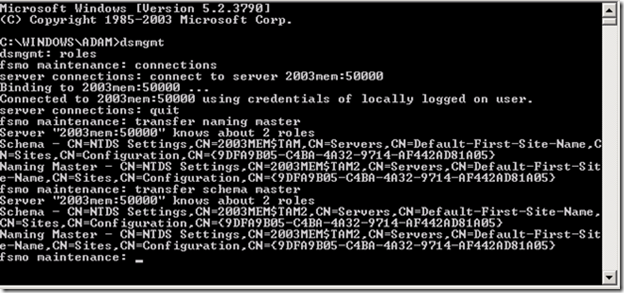How to Decommission an ADAM/ADLDS server and Add Additional Servers
Hello, LaNae here again. Recently I worked with a customer that was looking for a comprehensive document that outlined the steps for decommissioning a server that had an ADAM/ADLDS instance installed on it. I along with the customer realized there is no such document and you have to piece together multiple documents to get the steps. I decided to write this blog at the urging of the customer so that others do not have this issue.
For the purpose of this blog we will work with the following example:
Current Configuration
- There are 2 ADAM/AD LDS instances in one configuration set.
- Server A and Server B are the names of the servers that host the instances.
Goal
Add Server C and Server D and install and configure ADAM/AD LDS instances that will be part of the existing configuration set. Remove the ADAM/AD LDS instances from Server A and Server B and decommission them.
Overview of Steps
1. Install ADAM or the AD LDS role on servers C and D.
2. Install and configure the ADAM/AD LDS instances one on each server to be members of the existing configuration set. Steps for ADAM: Managing Configuration Sets Steps for AD LDS: Practice Managing Replica AD LDS Instances
3. Once replication is complete you will need to transfer the ADAM/AD LDS built-in FSMO roles from Server A or B which ever holds the roles to Server C or D. There are only 2 roles you will need to transfer, Naming Master and Schema Master. Replication in ADAM or AD LDS
Check Replication
From an ADAM command prompt or regular command prompt depending on whether this is ADAM or AD LDS you can run the following command to check replication.
Repadmin /showreps servername:portnumber of instance
Determining FSMO Role Holder
If ADAM is installed all the following steps must be done from the ADAM command prompt. If using ADLDS a regular command prompt is fine.
1. Type dsmgmt <enter>
2. Type roles <enter>
3. Type connections <enter>
4. Type connect to server servername:portnumber of instance <enter>
5. Type quit <enter>
6. Type select operation target <enter>
7. Type list roles for connected server <enter> Note: This should list who owns the FSMO roles.
Transfer FSMO Roles to new Server
The following steps need to be done from an ADAM command prompt if running ADAM.
1. Open an ADAM tools command prompt.
2. At the command prompt, type: dsmgmt
3. At the dsmgmt: command prompt, type: roles
4. At the FSMO maintenance: command prompt, type: connections
5. At the server connections: command prompt, type: connect to server servername:portnumber where servername:portnumber is the computer name and communications port number of the ADAM instance that you want to use as the new naming master or schema master.
6. At the server connections: command prompt, type: quit
7. At the FSMO maintenance: command prompt, type: transfer rolename
Remove the Instances from the old servers
1. Open Add or Remove Programs.
2. Click Change or Remove Programs, and then click the ADAM instance that you want to remove.
3. Click Remove.
1. To open Programs and Features, click Start, click Settings, click Control Panel, and then double-click Programs and Features.
2. Locate and click the AD LDS instance that you want to remove.
3. Click Uninstall.
You can now decommission Server A and B.
- Lanae Wade
Comments
Anonymous
February 02, 2010
Hi Lanae, I just have a off-track question for ADLDS on Windows 7. I downloaded ADLDS for Windows 7 from the below mentioned link on 12th Jan. http://www.microsoft.com/downloads/details.aspx?displaylang=en&FamilyID=a45059af-47a8-4c96-afe3-93dab7b5b658 Since then it appears that MS has taken this download down. Are there any issues with that download? Any idea when it will be available publically.Anonymous
February 03, 2010
No idea - I wasn't even aware that this product was made public. Looks like it was a mistake.Anonymous
February 03, 2010
ANd I am looking into this, of course. :)Anonymous
March 09, 2010
The comment has been removed

